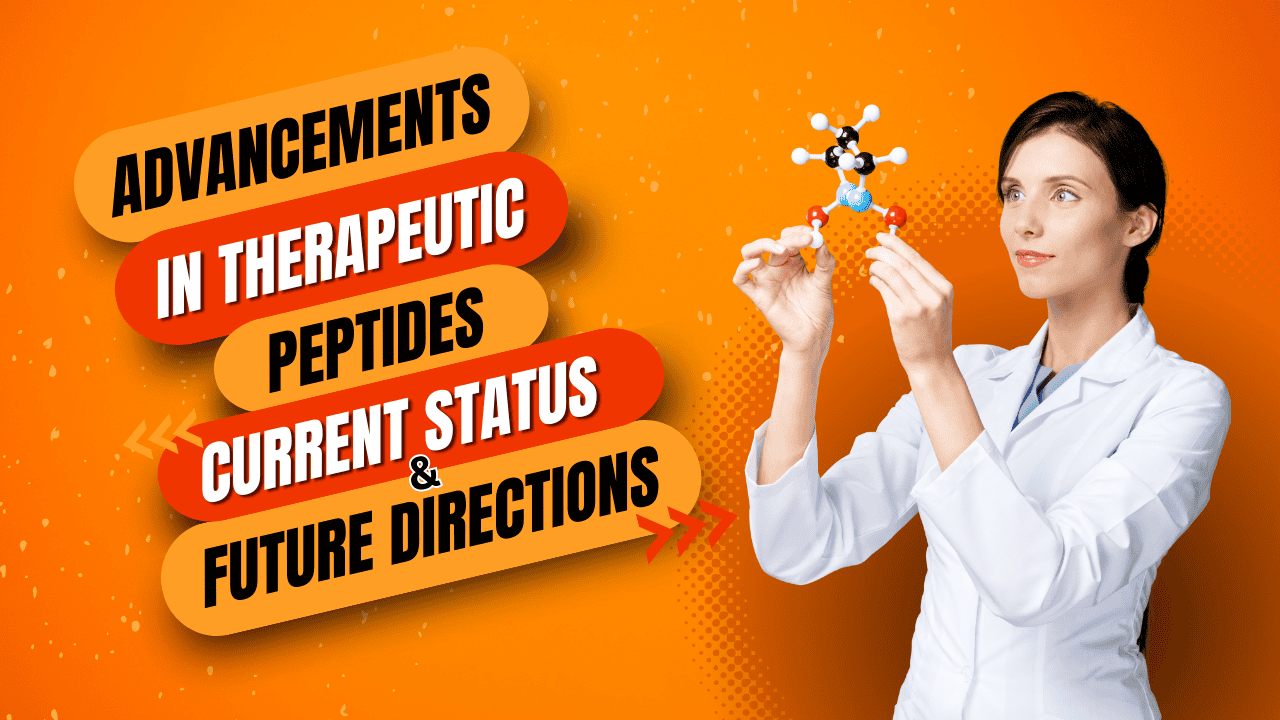

The world of modern medicine is bustling with innovations, and peptides are at the heart of many breakthroughs.
But what exactly are peptides?
Why should you care about them?
This article dives deep into the realm of peptides, uncovering their functions, roles, and groundbreaking applications in modern medicine.
Whether you’re a seasoned researcher or a curious reader, this comprehensive guide promises to enlighten you on why peptides are buzzing in the medical community.
Peptides are smaller chains of amino acids, often less than 50 amino acids long. They are the building blocks of proteins and play an essential role in various biological processes. These miniature molecules are involved in every aspect of life, from cell signaling to immune responses.
While proteins are long, complex molecules made up of hundreds of amino acids, peptides are shorter by nature. The peptide bond, which links amino acids together, is a fundamental component of both proteins and peptides, yet their structures and functions differ significantly due to their size and sequence.
Peptides present in the body regulate many biological activities. They act as hormones, enzymes, and even antimicrobial agents, making them crucial for maintaining health and combating diseases. The nature of peptides allows them to interact with various cellular components effectively.
Protein-peptide interactions are critical for numerous biological functions. These interactions can influence protein folding, stability, and signaling pathways, affecting how cells respond to their environment.
Peptide sequences aid in proper protein folding, ensuring that proteins achieve their functional three-dimensional shape. Misfolded proteins can lead to diseases, so understanding peptide involvement is essential for therapeutic development.
Peptide bonds are formed during the synthesis of peptides, linking two amino acids together in a chain. This chemical bond is vital for building peptide chains that ultimately form functional proteins.
Various techniques, including solid-phase peptide synthesis, are employed to synthesize peptides. These methods allow for precise control over peptide sequences and modifications, enhancing their application in research and medicine.
Solid-phase peptide synthesis involves anchoring the growing peptide chain to a solid support. This technique provides a straightforward process for synthesizing long and complex peptides with high purity and yield.
Liquid phase peptide synthesis involves dissolving reactants in a solution, allowing for the chemical reaction to create peptide bonds. Although less commonly used than solid-phase synthesis, it offers unique advantages for certain peptides.
Challenges in peptide synthesis include controlling the purity of the final peptide, managing side reactions, and optimizing conditions for large-scale production. Innovations in peptide chemistry aim to address these hurdles, paving the way for advanced peptide drugs.
Peptides signal by binding to specific receptors on cell surfaces, triggering various intracellular pathways. Their ability to interact with receptors makes them potent signaling molecules in the body.
Peptides influence numerous molecular pathways, from metabolic regulation to immune responses. Understanding these pathways helps in the design of peptide-based therapeutics that target specific cellular functions.
Peptides affect molecular dynamics by altering the behavior of proteins and other molecules. This can lead to changes in cellular activities, offering potential therapeutic benefits for a wide range of conditions.
Peptides are used in drug design due to their high specificity, efficacy, and low toxicity. They can be tailored to target particular cells or pathways, making them ideal candidates for precision medicine.
The production of antimicrobial peptides offers a new frontier in fighting bacterial infections. These peptides can disrupt bacterial cell membranes, providing an effective alternative to traditional antibiotics.
Peptides are used in cancer therapy to target tumor cells selectively, sparing healthy tissue. Peptide vaccines and peptide drug discovery efforts focus on harnessing their potential to boost the immune system and inhibit cancer growth.
Peptides also play a pivotal role in treating cardiovascular diseases. Natriuretic peptides, such as brain natriuretic peptide and c-type natriuretic peptide, help regulate blood pressure and fluid balance, offering therapeutic benefits.
Peptides regulate metabolic processes, influencing conditions like diabetes and obesity. Peptide hormones, like insulin, are well-known treatments that provide life-saving interventions for metabolic disorders.
Peptides are instrumental in molecular imaging, enabling the visualization of biological processes in real-time. Radiolabeled peptides are used to detect specific tissues or diseases, providing critical information for diagnosis.
Diagnostic imaging techniques utilize peptides to target specific biomarkers, enhancing the accuracy and sensitivity of imaging modalities like PET and MRI. Using peptides allows for earlier and more precise disease detection.
Peptide-based imaging agents are designed to bind to specific targets, improving the clarity and contrast in imaging scans. Their effectiveness lies in their ability to home in on disease-specific markers with minimal off-target effects.
Peptide-based drugs are medications derived from peptides that target specific biological processes. These drugs are designed using peptides to treat various conditions, from metabolic disorders to autoimmune diseases.
Peptide therapeutics offer numerous advantages, including high specificity, fewer side effects, and the ability to modulate complex biological pathways. Peptide drugs are increasingly being explored for their potential in personalized medicine.
Peptides target specific cells and tissues by binding to unique receptors or molecular targets. This targeting ability makes them suitable for drug delivery systems that aim to deliver therapeutics precisely where needed.
Peptide vaccines represent a promising area of research, with peptides that mimic pathogen components to elicit an immune response. These vaccines offer a safer and more targeted approach to immunization.
Peptides play a beneficial role in pain management and treating neurological disorders. Calcitonin gene-related peptide and other neuropeptides are explored for their therapeutic potential in conditions like migraines and neurodegenerative diseases.
Peptides regulate cellular activities by participating in signaling pathways and modulating the function of various cellular components. This regulation is crucial for maintaining homeostasis and responding to environmental changes.
Cell signaling involves peptides binding to receptors and triggering specific responses. These peptide-receptor interactions are essential for processes like growth, differentiation, and immune responses.
Peptides influence cell growth and repair by promoting cell proliferation and regeneration. Bioactive peptides are known for their ability to stimulate healing and tissue repair, making them valuable in regenerative medicine.
Peptides modulate the immune system by acting as signaling molecules that activate or suppress immune responses. This modulation is critical for combating infections, controlling inflammation, and preventing autoimmune diseases.
Peptides are used in cosmetics and skincare to enhance skin health and appearance. Peptide-based products can reduce wrinkles, enhance collagen production, and improve skin hydration, providing a youthful and radiant look.
Peptides have various industrial applications, including their use in food additives, agricultural products, and biotechnological processes. They offer sustainable solutions due to their biodegradability and low toxicity.
Peptides are extensively studied in clinical trials, exploring their potential as therapeutic agents for numerous diseases. Research focuses on developing peptide drugs that can offer new treatment options with fewer side effects.
The economic impact of peptide therapeutics is significant, with the market for peptide-based drugs and treatments growing rapidly. This growth reflects the potential of peptides to address unmet medical needs and drive innovation in the pharmaceutical industry.
Innovations in peptide research include novel synthesis techniques, advanced drug delivery systems, and the discovery of new bioactive peptides. These advancements are pushing the boundaries of what peptides can achieve in medicine.
Advances in technology, such as high-throughput screening and artificial intelligence, are revolutionizing peptide applications. These technologies enable the identification of new peptide candidates and optimize their design for therapeutic use.
Ethical considerations in peptide therapeutics involve ensuring patient safety, equitable access to treatments, and addressing potential long-term effects. Ethical frameworks guide the development and use of peptide-based therapies.
Market trends indicate a growing demand for peptide-based products, driven by their effectiveness and increasing consumer awareness. Peptides are expected to play a more prominent role in healthcare, cosmetics, and nutrition.
With all these insights into the fascinating world of peptides, it’s clear why they are considered the next frontier in medical science and beyond. Whether it’s developing new drugs, diagnosing diseases, or enhancing our daily skincare routine, peptides play an essential and transformative role.
Peptides are not proteins, but they are the building blocks of proteins. A peptide is a short chain of amino acid residues, typically less than 50, linked by peptide bonds. Proteins are longer chains of amino acids that fold into complex structures.
Antimicrobial peptides (AMPs) are being explored as alternatives to traditional antibiotics. AMPs can disrupt bacterial cell membranes, reducing resistance issues. Clinical trials of synthetic peptides with antimicrobial properties are ongoing, showing promising results against multi-drug resistant infections.
Yes, peptides have isoelectric points (pI). The isoelectric point is the pH at which a peptide carries no net electrical charge. It depends on the peptide’s amino acid composition and their respective pKa values.
The current state of peptide drug discovery is robust, emphasizing the development of peptide-based therapeutics. Researchers are leveraging natural peptides and synthetic analogues to create drugs with higher specificity and fewer side effects. This approach heralds a new era in precision medicine.
Absolutely, many researchers aim to mimic natural peptides found in the body to develop effective therapeutics. These endogenous peptides serve as smart functional building blocks, offering a blueprint for designing new peptide drugs.
Protein production services often involve the synthesis of peptides, as peptides are the building blocks of proteins. Techniques like solid-phase peptide synthesis are used to create peptide chains that fold into functional proteins.
Peptide synthesis is the process of creating peptides by chemically linking amino acids in a specific sequence. This can be achieved through methods such as solid-phase peptide synthesis and liquid-phase synthesis.
Yes, synthetic peptides can be designed to mimic the activity of natural peptides in the body. These synthetic peptide drugs offer targeted treatment options with potentially fewer side effects compared to traditional medications.
Biologically active peptides are short chains of amino acids that have a specific biological effect. These active peptides can act as hormones, antibiotics, or signaling molecules with therapeutic potential.
Different types of peptides include antimicrobial peptides, hormone peptides, and signaling peptides. Each type has unique functions in the body or potential therapeutic applications. Some popular peptides are used in clinical settings for their specific activities.
Dr. Samuel J. Danishefsky is a prolific chemist renowned for his groundbreaking work in the synthesis of bioactive peptides and complex molecules. With over four decades in the field of peptide and protein chemistry, Dr. Danishefsky has significantly advanced the understanding of peptide synthesis and its applications in medicine. He has developed innovative methodologies for the solid-phase synthesis and modification of peptides, contributing to the development of peptide-based drugs and therapeutic agents.
Dr. Danishefsky’s notable publications include:
Dr. Danishefsky has received numerous prestigious awards, including the Wolf Prize in Chemistry and election to the National Academy of Sciences, underscoring his authority and trustworthiness in peptide research. His contributions have paved the way for the synthesis of complex bioactive peptides, impacting drug discovery and development.
Dr. Jean Martinez is a leading figure in peptide science, known for his innovative research in peptide synthesis, modification, and drug delivery systems. With a specialization in the development of synthetic peptides and their therapeutic applications, Dr. Martinez has made substantial contributions to peptide drug discovery and the understanding of peptide pharmacology.
Key publications by Dr. Martinez include:
Dr. Martinez’s research is characterized by its innovation and practical application, making significant advancements in the use of peptides as therapeutic agents. His contributions have been recognized with awards such as the European Peptide Society’s Lifetime Achievement Award. Dr. Martinez’s work continues to influence the peptide research community, driving forward the development of effective peptide-based therapeutics.
Albada, B., & Metzler-Nolte, N. (2016). Organometallic–Peptide Bioconjugates: synthetic strategies and medicinal applications. Chemical Reviews, 116(19), 11797–11839. https://doi.org/10.1021/acs.chemrev.6b00166
Hersh, J., Broyles, D., Capcha, J. M. C., Dikici, E., Shehadeh, L. A., Daunert, S., & Deo, S. (2020). Peptide-Modified biopolymers for biomedical applications. ACS Applied Bio Materials, 4(1), 229–251. https://doi.org/10.1021/acsabm.0c01145
Jeong, S., Lee, K., Yoo, S. H., Lee, H., & Kwon, S. (2022). Crystalline Metal‐Peptide Networks: Structures, applications, and future Outlook. ChemBioChem, 24(2). https://doi.org/10.1002/cbic.202200448
Matsuura, K., & Inaba, H. (2023). Photoresponsive peptide materials: Spatiotemporal control of self-assembly and biological functions. Biophysics Reviews, 4(4). https://doi.org/10.1063/5.0179171
Potter, L. R., Yoder, A. R., Flora, D. R., Antos, L. K., & Dickey, D. M. (2008). Natriuretic peptides: their structures, receptors, physiologic functions and therapeutic applications. Handbook of Experimental Pharmacology, 341–366. https://doi.org/10.1007/978-3-540-68964-5_15
Wang, H., Feng, Z., & Xu, B. (2019). Assemblies of Peptides in a Complex Environment and their Applications. Angewandte Chemie International Edition, 58(31), 10423–10432. https://doi.org/10.1002/anie.201814552
Wang, M., Li, L., Zhang, L., Zhao, J., Jiang, Z., & Wang, W. (2021). Peptide-Derived Biosensors and their applications in Tumor Immunology-Related Detection. Analytical Chemistry, 94(1), 431–441. https://doi.org/10.1021/acs.analchem.1c04461
Wang, Y., Xia, K., Wang, L., Wu, M., Sang, X., Wan, K., Zhang, X., Liu, X., & Wei, G. (2021). Peptide‐Engineered fluorescent nanomaterials: structure design, function tailoring, and biomedical applications. Small, 17(5). https://doi.org/10.1002/smll.202005578
ALL ARTICLES AND PRODUCT INFORMATION PROVIDED ON THIS WEBSITE ARE FOR INFORMATIONAL AND EDUCATIONAL PURPOSES ONLY. The products offered on this website are intended solely for research and laboratory use. These products are not intended for human or animal consumption. They are not medicines or drugs and have not been evaluated or approved by the FDA to diagnose, treat, cure, or prevent any disease or medical condition. Any form of bodily introduction is strictly prohibited by law.





Discount Applied Successfully!
Your savings have been added to the cart.